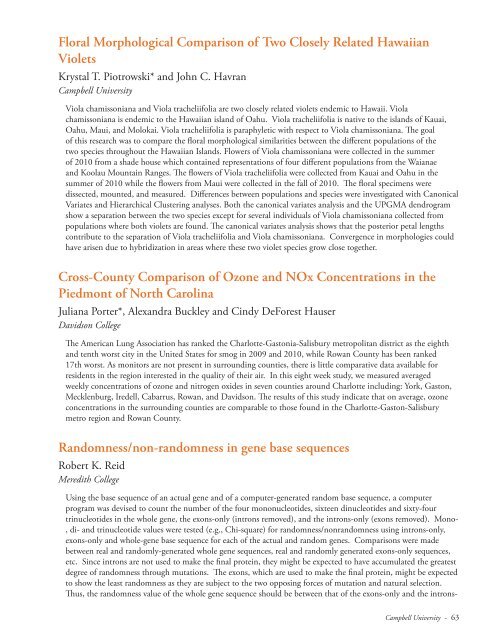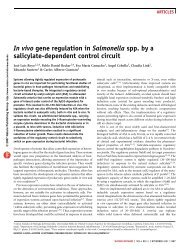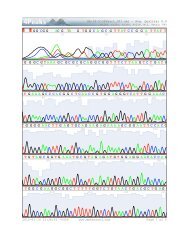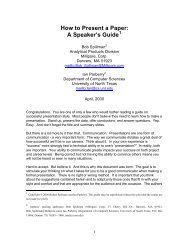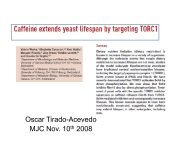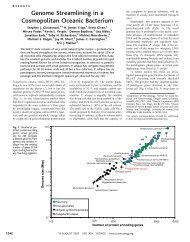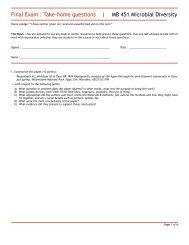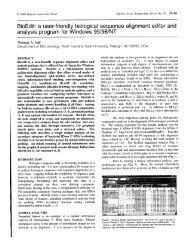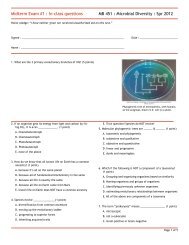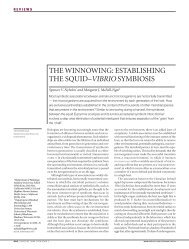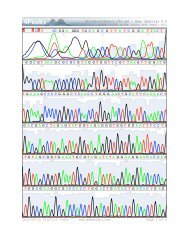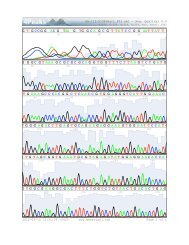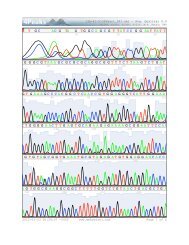Schedule and Program - North Carolina Academy of Science
Schedule and Program - North Carolina Academy of Science
Schedule and Program - North Carolina Academy of Science
Create successful ePaper yourself
Turn your PDF publications into a flip-book with our unique Google optimized e-Paper software.
Floral Morphological Comparison <strong>of</strong> Two Closely Related HawaiianVioletsKrystal T. Piotrowski* <strong>and</strong> John C. HavranCampbell UniversityViola chamissoniana <strong>and</strong> Viola tracheliifolia are two closely related violets endemic to Hawaii. Violachamissoniana is endemic to the Hawaiian isl<strong>and</strong> <strong>of</strong> Oahu. Viola tracheliifolia is native to the isl<strong>and</strong>s <strong>of</strong> Kauai,Oahu, Maui, <strong>and</strong> Molokai. Viola tracheliifolia is paraphyletic with respect to Viola chamissoniana. The goal<strong>of</strong> this research was to compare the floral morphological similarities between the different populations <strong>of</strong> thetwo species throughout the Hawaiian Isl<strong>and</strong>s. Flowers <strong>of</strong> Viola chamissoniana were collected in the summer<strong>of</strong> 2010 from a shade house which contained representations <strong>of</strong> four different populations from the Waianae<strong>and</strong> Koolau Mountain Ranges. The flowers <strong>of</strong> Viola tracheliifolia were collected from Kauai <strong>and</strong> Oahu in thesummer <strong>of</strong> 2010 while the flowers from Maui were collected in the fall <strong>of</strong> 2010. The floral specimens weredissected, mounted, <strong>and</strong> measured. Differences between populations <strong>and</strong> species were investigated with CanonicalVariates <strong>and</strong> Hierarchical Clustering analyses. Both the canonical variates analysis <strong>and</strong> the UPGMA dendrogramshow a separation between the two species except for several individuals <strong>of</strong> Viola chamissoniana collected frompopulations where both violets are found. The canonical variates analysis shows that the posterior petal lengthscontribute to the separation <strong>of</strong> Viola tracheliifolia <strong>and</strong> Viola chamissoniana. Convergence in morphologies couldhave arisen due to hybridization in areas where these two violet species grow close together.Cross-County Comparison <strong>of</strong> Ozone <strong>and</strong> NOx Concentrations in thePiedmont <strong>of</strong> <strong>North</strong> <strong>Carolina</strong>Juliana Porter*, Alex<strong>and</strong>ra Buckley <strong>and</strong> Cindy DeForest HauserDavidson CollegeThe American Lung Association has ranked the Charlotte-Gastonia-Salisbury metropolitan district as the eighth<strong>and</strong> tenth worst city in the United States for smog in 2009 <strong>and</strong> 2010, while Rowan County has been ranked17th worst. As monitors are not present in surrounding counties, there is little comparative data available forresidents in the region interested in the quality <strong>of</strong> their air. In this eight week study, we measured averagedweekly concentrations <strong>of</strong> ozone <strong>and</strong> nitrogen oxides in seven counties around Charlotte including: York, Gaston,Mecklenburg, Iredell, Cabarrus, Rowan, <strong>and</strong> Davidson. The results <strong>of</strong> this study indicate that on average, ozoneconcentrations in the surrounding counties are comparable to those found in the Charlotte-Gaston-Salisburymetro region <strong>and</strong> Rowan County.R<strong>and</strong>omness/non-r<strong>and</strong>omness in gene base sequencesRobert K. ReidMeredith CollegeUsing the base sequence <strong>of</strong> an actual gene <strong>and</strong> <strong>of</strong> a computer-generated r<strong>and</strong>om base sequence, a computerprogram was devised to count the number <strong>of</strong> the four mononucleotides, sixteen dinucleotides <strong>and</strong> sixty-fourtrinucleotides in the whole gene, the exons-only (introns removed), <strong>and</strong> the introns-only (exons removed). Mono-, di- <strong>and</strong> trinucleotide values were tested (e.g., Chi-square) for r<strong>and</strong>omness/nonr<strong>and</strong>omness using introns-only,exons-only <strong>and</strong> whole-gene base sequence for each <strong>of</strong> the actual <strong>and</strong> r<strong>and</strong>om genes. Comparisons were madebetween real <strong>and</strong> r<strong>and</strong>omly-generated whole gene sequences, real <strong>and</strong> r<strong>and</strong>omly generated exons-only sequences,etc. Since introns are not used to make the final protein, they might be expected to have accumulated the greatestdegree <strong>of</strong> r<strong>and</strong>omness through mutations. The exons, which are used to make the final protein, might be expectedto show the least r<strong>and</strong>omness as they are subject to the two opposing forces <strong>of</strong> mutation <strong>and</strong> natural selection.Thus, the r<strong>and</strong>omness value <strong>of</strong> the whole gene sequence should be between that <strong>of</strong> the exons-only <strong>and</strong> the introns-Campbell University - 63


